5
1
0
2
c
e
D
1
1
]
V
C
.
s
c
[
3
v
7
6
5
0
0
.
2
1
5
1
:
v
i
X
r
a
Rethinking the Inception Architecture for Computer Vision
Christian Szegedy
Google Inc.
szegedy@google.com
Vincent Vanhoucke
Sergey Ioffe
vanhoucke@google.com
sioffe@google.com
Jonathon Shlens
shlens@google.com
Zbigniew Wojna
University College London
zbigniewwojna@gmail.com
Abstract
Convolutional networks are at the core of most state-
of-the-art computer vision solutions for a wide variety of
tasks. Since 2014 very deep convolutional networks started
to become mainstream, yielding substantial gains in vari-
ous benchmarks. Although increased model size and com-
putational cost tend to translate to immediate quality gains
for most tasks (as long as enough labeled data is provided
for training), computational efficiency and low parameter
count are still enabling factors for various use cases such as
mobile vision and big-data scenarios. Here we are explor-
ing ways to scale up networks in ways that aim at utilizing
the added computation as efficiently as possible by suitably
factorized convolutions and aggressive regularization. We
benchmark our methods on the ILSVRC 2012 classification
challenge validation set demonstrate substantial gains over
the state of the art: 21.2% top-1 and 5.6% top-5 error for
single frame evaluation using a network with a computa-
tional cost of 5 billion multiply-adds per inference and with
using less than 25 million parameters. With an ensemble of
4 models and multi-crop evaluation, we report 3.5% top-5
error and 17.3% top-1 error.
1. Introduction
Since the 2012 ImageNet competition [16] winning en-
try by Krizhevsky et al [9], their network “AlexNet” has
been successfully applied to a larger variety of computer
vision tasks, for example to object-detection [5], segmen-
tation [12], human pose estimation [22], video classifica-
tion [8], object tracking [23], and superresolution [3].
These successes spurred a new line of research that fo-
cused on finding higher performing convolutional neural
networks. Starting in 2014, the quality of network architec-
tures significantly improved by utilizing deeper and wider
networks. VGGNet [18] and GoogLeNet [20] yielded simi-
larly high performance in the 2014 ILSVRC [16] classifica-
tion challenge. One interesting observation was that gains
in the classification performance tend to transfer to signifi-
cant quality gains in a wide variety of application domains.
This means that architectural improvements in deep con-
volutional architecture can be utilized for improving perfor-
mance for most other computer vision tasks that are increas-
ingly reliant on high quality, learned visual features. Also,
improvements in the network quality resulted in new appli-
cation domains for convolutional networks in cases where
AlexNet features could not compete with hand engineered,
crafted solutions, e.g. proposal generation in detection[4].
Although VGGNet [18] has the compelling feature of
architectural simplicity, this comes at a high cost: evalu-
ating the network requires a lot of computation. On the
other hand, the Inception architecture of GoogLeNet [20]
was also designed to perform well even under strict con-
straints on memory and computational budget. For exam-
ple, GoogleNet employed only 5 million parameters, which
represented a 12× reduction with respect to its predeces-
sor AlexNet, which used 60 million parameters. Further-
more, VGGNet employed about 3x more parameters than
AlexNet.
The computational cost of Inception is also much lower
than VGGNet or its higher performing successors [6]. This
has made it feasible to utilize Inception networks in big-data
scenarios[17], [13], where huge amount of data needed to
be processed at reasonable cost or scenarios where memory
or computational capacity is inherently limited, for example
in mobile vision settings. It is certainly possible to mitigate
parts of these issues by applying specialized solutions to tar-
get memory use [2], [15] or by optimizing the execution of
certain operations via computational tricks [10]. However,
these methods add extra complexity. Furthermore, these
methods could be applied to optimize the Inception archi-
tecture as well, widening the efficiency gap again.
Still, the complexity of the Inception architecture makes
1
�
it more difficult to make changes to the network. If the ar-
chitecture is scaled up naively, large parts of the computa-
tional gains can be immediately lost. Also, [20] does not
provide a clear description about the contributing factors
that lead to the various design decisions of the GoogLeNet
architecture. This makes it much harder to adapt it to new
use-cases while maintaining its efficiency. For example,
if it is deemed necessary to increase the capacity of some
Inception-style model, the simple transformation of just
doubling the number of all filter bank sizes will lead to a
4x increase in both computational cost and number of pa-
rameters. This might prove prohibitive or unreasonable in a
lot of practical scenarios, especially if the associated gains
are modest. In this paper, we start with describing a few
general principles and optimization ideas that that proved
to be useful for scaling up convolution networks in efficient
ways. Although our principles are not limited to Inception-
type networks, they are easier to observe in that context as
the generic structure of the Inception style building blocks
is flexible enough to incorporate those constraints naturally.
This is enabled by the generous use of dimensional reduc-
tion and parallel structures of the Inception modules which
allows for mitigating the impact of structural changes on
nearby components. Still, one needs to be cautious about
doing so, as some guiding principles should be observed to
maintain high quality of the models.
2. General Design Principles
Here we will describe a few design principles based
on large-scale experimentation with various architectural
choices with convolutional networks. At this point, the util-
ity of the principles below are speculative and additional
future experimental evidence will be necessary to assess
their accuracy and domain of validity. Still, grave devia-
tions from these principles tended to result in deterioration
in the quality of the networks and fixing situations where
those deviations were detected resulted in improved archi-
tectures in general.
1. Avoid representational bottlenecks, especially early in
the network. Feed-forward networks can be repre-
sented by an acyclic graph from the input layer(s) to
the classifier or regressor. This defines a clear direction
for the information flow. For any cut separating the in-
puts from the outputs, one can access the amount of
information passing though the cut. One should avoid
bottlenecks with extreme compression. In general the
representation size should gently decrease from the in-
puts to the outputs before reaching the final represen-
tation used for the task at hand. Theoretically, infor-
mation content can not be assessed merely by the di-
mensionality of the representation as it discards impor-
tant factors like correlation structure; the dimensional-
ity merely provides a rough estimate of information
content.
2. Higher dimensional representations are easier to pro-
cess locally within a network. Increasing the activa-
tions per tile in a convolutional network allows for
more disentangled features. The resulting networks
will train faster.
3. Spatial aggregation can be done over lower dimen-
sional embeddings without much or any loss in rep-
resentational power. For example, before performing a
more spread out (e.g. 3 × 3) convolution, one can re-
duce the dimension of the input representation before
the spatial aggregation without expecting serious ad-
verse effects. We hypothesize that the reason for that
is the strong correlation between adjacent unit results
in much less loss of information during dimension re-
duction, if the outputs are used in a spatial aggrega-
tion context. Given that these signals should be easily
compressible, the dimension reduction even promotes
faster learning.
4. Balance the width and depth of the network. Optimal
performance of the network can be reached by balanc-
ing the number of filters per stage and the depth of
the network. Increasing both the width and the depth
of the network can contribute to higher quality net-
works. However, the optimal improvement for a con-
stant amount of computation can be reached if both are
increased in parallel. The computational budget should
therefore be distributed in a balanced way between the
depth and width of the network.
Although these principles might make sense, it is not
straightforward to use them to improve the quality of net-
works out of box. The idea is to use them judiciously in
ambiguous situations only.
3. Factorizing Convolutions with Large Filter
Size
Much of the original gains of the GoogLeNet net-
work [20] arise from a very generous use of dimension re-
duction. This can be viewed as a special case of factorizing
convolutions in a computationally efficient manner. Con-
sider for example the case of a 1 × 1 convolutional layer
followed by a 3 × 3 convolutional layer. In a vision net-
work, it is expected that the outputs of near-by activations
are highly correlated. Therefore, we can expect that their
activations can be reduced before aggregation and that this
should result in similarly expressive local representations.
Here we explore other ways of factorizing convolutions
in various settings, especially in order to increase the com-
putational efficiency of the solution. Since Inception net-
works are fully convolutional, each weight corresponds to
�
Figure 1. Mini-network replacing the 5 × 5 convolutions.
one multiplication per activation. Therefore, any reduction
in computational cost results in reduced number of param-
eters. This means that with suitable factorization, we can
end up with more disentangled parameters and therefore
with faster training. Also, we can use the computational
and memory savings to increase the filter-bank sizes of our
network while maintaining our ability to train each model
replica on a single computer.
3.1. Factorization into smaller convolutions
Convolutions with larger spatial filters (e.g. 5 × 5 or
7 × 7) tend to be disproportionally expensive in terms of
computation. For example, a 5 × 5 convolution with n fil-
ters over a grid with m filters is 25/9 = 2.78 times more
computationally expensive than a 3 × 3 convolution with
the same number of filters. Of course, a 5× 5 filter can cap-
ture dependencies between signals between activations of
units further away in the earlier layers, so a reduction of the
geometric size of the filters comes at a large cost of expres-
siveness. However, we can ask whether a 5× 5 convolution
could be replaced by a multi-layer network with less pa-
rameters with the same input size and output depth. If we
zoom into the computation graph of the 5 × 5 convolution,
we see that each output looks like a small fully-connected
network sliding over 5× 5 tiles over its input (see Figure 1).
Since we are constructing a vision network, it seems natural
to exploit translation invariance again and replace the fully
connected component by a two layer convolutional archi-
tecture: the first layer is a 3× 3 convolution, the second is a
fully connected layer on top of the 3 × 3 output grid of the
first layer (see Figure 1). Sliding this small network over
the input activation grid boils down to replacing the 5 × 5
convolution with two layers of 3 × 3 convolution (compare
Figure 4 with 5).
This setup clearly reduces the parameter count by shar-
ing the weights between adjacent tiles. To analyze the ex-
Figure 2. One of several control experiments between two Incep-
tion models, one of them uses factorization into linear + ReLU
layers, the other uses two ReLU layers. After 3.86 million opera-
tions, the former settles at 76.2%, while the latter reaches 77.2%
top-1 Accuracy on the validation set.
√
pected computational cost savings, we will make a few sim-
plifying assumptions that apply for the typical situations:
We can assume that n = αm, that is that we want to
change the number of activations/unit by a constant alpha
factor. Since the 5 × 5 convolution is aggregating, α is
typically slightly larger than one (around 1.5 in the case
of GoogLeNet). Having a two layer replacement for the
5 × 5 layer, it seems reasonable to reach this expansion in
two steps: increasing the number of filters by
α in both
steps. In order to simplify our estimate by choosing α = 1
(no expansion), If we would naivly slide a network without
reusing the computation between neighboring grid tiles, we
would increase the computational cost. sliding this network
can be represented by two 3× 3 convolutional layers which
reuses the activations between adjacent tiles. This way, we
25 × reduction of computation, resulting
end up with a net 9+9
in a relative gain of 28% by this factorization. The exact
same saving holds for the parameter count as each parame-
ter is used exactly once in the computation of the activation
of each unit. Still, this setup raises two general questions:
Does this replacement result in any loss of expressiveness?
If our main goal is to factorize the linear part of the compu-
tation, would it not suggest to keep linear activations in the
first layer? We have ran several control experiments (for ex-
ample see figure 2) and using linear activation was always
inferior to using rectified linear units in all stages of the fac-
torization. We attribute this gain to the enhanced space of
variations that the network can learn especially if we batch-
normalize [7] the output activations. One can see similar
effects when using linear activations for the dimension re-
duction components.
3.2. Spatial Factorization into Asymmetric Convo-
lutions
The above results suggest that convolutions with filters
larger 3 × 3 a might not be generally useful as they can
always be reduced into a sequence of 3 × 3 convolutional
00.511.522.533.54x 10600.10.20.30.40.50.60.70.8IterationTop−1 AccuracyFactorization with Linear vs ReLU activation ReLULinear�
Figure 3. Mini-network replacing the 3 × 3 convolutions. The
lower layer of this network consists of a 3 × 1 convolution with 3
output units.
Figure 4. Original Inception module as described in [20].
layers. Still we can ask the question whether one should
factorize them into smaller, for example 2× 2 convolutions.
However, it turns out that one can do even better than 2 × 2
by using asymmetric convolutions, e.g. n × 1. For example
using a 3 × 1 convolution followed by a 1 × 3 convolution
is equivalent to sliding a two layer network with the same
receptive field as in a 3 × 3 convolution (see figure 3). Still
the two-layer solution is 33% cheaper for the same number
of output filters, if the number of input and output filters is
equal. By comparison, factorizing a 3 × 3 convolution into
a two 2 × 2 convolution represents only a 11% saving of
computation.
In theory, we could go even further and argue that one
can replace any n × n convolution by a 1 × n convolu-
Figure 5. Inception modules where each 5 × 5 convolution is re-
placed by two 3 × 3 convolution, as suggested by principle 3 of
Section 2.
tion followed by a n× 1 convolution and the computational
cost saving increases dramatically as n grows (see figure 6).
In practice, we have found that employing this factorization
does not work well on early layers, but it gives very good re-
sults on medium grid-sizes (On m× m feature maps, where
m ranges between 12 and 20). On that level, very good re-
sults can be achieved by using 1 × 7 convolutions followed
by 7 × 1 convolutions.
4. Utility of Auxiliary Classifiers
[20] has introduced the notion of auxiliary classifiers to
improve the convergence of very deep networks. The origi-
nal motivation was to push useful gradients to the lower lay-
ers to make them immediately useful and improve the con-
vergence during training by combating the vanishing gra-
dient problem in very deep networks. Also Lee et al[11]
argues that auxiliary classifiers promote more stable learn-
ing and better convergence.
Interestingly, we found that
auxiliary classifiers did not result in improved convergence
early in the training:
the training progression of network
with and without side head looks virtually identical before
both models reach high accuracy. Near the end of training,
the network with the auxiliary branches starts to overtake
the accuracy of the network without any auxiliary branch
and reaches a slightly higher plateau.
Also [20] used two side-heads at different stages in the
network. The removal of the lower auxiliary branch did not
have any adverse effect on the final quality of the network.
Together with the earlier observation in the previous para-
1x1 1x1 5x5 3x3 Pool 1x1 BaseFilter Concat1x1 1x1 1x1 3x3 3x3 Pool 1x1 BaseFilter Concat3x3 1x1 �
Figure 7. Inception modules with expanded the filter bank outputs.
This architecture is used on the coarsest (8 × 8) grids to promote
high dimensional representations, as suggested by principle 2 of
Section 2. We are using this solution only on the coarsest grid,
since that is the place where producing high dimensional sparse
representation is the most critical as the ratio of local processing
(by 1 × 1 convolutions) is increased compared to the spatial ag-
gregation.
Figure 8. Auxiliary classifier on top of the last 17×17 layer. Batch
normalization[7] of the layers in the side head results in a 0.4%
absolute gain in top-1 accuracy. The lower axis shows the number
of itertions performed, each with batch size 32.
reducing the computational cost by a quarter. However, this
creates a representational bottlenecks as the overall dimen-
sionality of the representation drops to ( d
2 )2k resulting in
less expressive networks (see Figure 9). Instead of doing so,
we suggest another variant the reduces the computational
cost even further while removing the representational bot-
tleneck. (see Figure 10). We can use two parallel stride 2
blocks: P and C. P is a pooling layer (either average or
maximum pooling) the activation, both of them are stride 2
the filter banks of which are concatenated as in figure 10.
Figure 6. Inception modules after the factorization of the n × n
convolutions. In our proposed architecture, we chose n = 7 for
the 17 × 17 grid. (The filter sizes are picked using principle 3)
.
graph, this means that original the hypothesis of [20] that
these branches help evolving the low-level features is most
likely misplaced. Instead, we argue that the auxiliary clas-
sifiers act as regularizer. This is supported by the fact that
the main classifier of the network performs better if the side
branch is batch-normalized [7] or has a dropout layer. This
also gives a weak supporting evidence for the conjecture
that batch normalization acts as a regularizer.
5. Efficient Grid Size Reduction
Traditionally, convolutional networks used some pooling
operation to decrease the grid size of the feature maps. In
order to avoid a representational bottleneck, before apply-
ing maximum or average pooling the activation dimension
of the network filters is expanded. For example, starting a
d× d grid with k filters, if we would like to arrive at a d
2 × d
2
grid with 2k filters, we first need to compute a stride-1 con-
volution with 2k filters and then apply an additional pooling
step. This means that the overall computational cost is dom-
inated by the expensive convolution on the larger grid using
2d2k2 operations. One possibility would be to switch to
pooling with convolution and therefore resulting in 2( d
2 )2k2
1x1 1x1 1xn Pool 1x1 BaseFilter Concatnx1 1xn nx1 1xn nx1 1x1 1x1 1x1 3x3 Pool 1x1 BaseFilter Concat1x3 1x3 1x1 3x1 3x1 17x17x7685x5x7688x8x1280Inception5x5x1281x1x10245x5 Average pooling with stride 31x1 Convolution Fully connected...�
type
conv
conv
conv padded
pool
conv
conv
conv
3×Inception
5×Inception
2×Inception
pool
linear
softmax
patch size/stride
or remarks
3×3/2
3×3/1
3×3/1
3×3/2
3×3/1
3×3/2
3×3/1
As in figure 5
As in figure 6
As in figure 7
8 × 8
logits
classifier
input size
299×299×3
149×149×32
147×147×32
147×147×64
73×73×64
71×71×80
35×35×192
35×35×288
17×17×768
8×8×1280
8 × 8 × 2048
1 × 1 × 2048
1 × 1 × 1000
Table 1. The outline of the proposed network architecture. The
output size of each module is the input size of the next one. We
are using variations of reduction technique depicted Figure 10 to
reduce the grid sizes between the Inception blocks whenever ap-
plicable. We have marked the convolution with 0-padding, which
is used to maintain the grid size. 0-padding is also used inside
those Inception modules that do not reduce the grid size. All other
layers do not use padding. The various filter bank sizes are chosen
to observe principle 4 from Section 2.
However, we have observed that the quality of the network
is relatively stable to variations as long as the principles
from Section 2 are observed. Although our network is 42
layers deep, our computation cost is only about 2.5 higher
than that of GoogLeNet and it is still much more efficient
than VGGNet.
exp(zk)
7. Model Regularization via Label Smoothing
Here we propose a mechanism to regularize the classifier
layer by estimating the marginalized effect of label-dropout
during training.
For each training example x, our model computes the
probability of each label k ∈ {1 . . . K}: p(k|x) =
K
i=1 exp(zi). Here, zi are the logits or unnormalized log-
probabilities. Consider the ground-truth distribution over
labels q(k|x) for this training example, normalized so that
k q(k|x) = 1. For brevity, let us omit the dependence
ample as the cross entropy: = −K
of p and q on example x. We define the loss for the ex-
k=1 log(p(k))q(k).
Minimizing this is equivalent to maximizing the expected
log-likelihood of a label, where the label is selected accord-
ing to its ground-truth distribution q(k). Cross-entropy loss
is differentiable with respect to the logits zk and thus can be
used for gradient training of deep models. The gradient has
= p(k)− q(k), which is bounded
a rather simple form: ∂
between −1 and 1.
∂zk
Consider the case of a single ground-truth label y, so
that q(y) = 1 and q(k) = 0 for all k = y. In this case,
Figure 9. Two alternative ways of reducing the grid size. The so-
lution on the left violates the principle 1 of not introducing an rep-
resentational bottleneck from Section 2. The version on the right
is 3 times more expensive computationally.
Figure 10. Inception module that reduces the grid-size while ex-
pands the filter banks. It is both cheap and avoids the representa-
tional bottleneck as is suggested by principle 1. The diagram on
the right represents the same solution but from the perspective of
grid sizes rather than the operations.
6. Inception-v2
Here we are connecting the dots from above and pro-
pose a new architecture with improved performance on the
ILSVRC 2012 classification benchmark. The layout of our
network is given in table 1. Note that we have factorized
the traditional 7 × 7 convolution into three 3 × 3 convolu-
tions based on the same ideas as described in section 3.1.
For the Inception part of the network, we have 3 traditional
inception modules at the 35× 35 with 288 filters each. This
is reduced to a 17 × 17 grid with 768 filters using the grid
reduction technique described in section 5. This is is fol-
lowed by 5 instances of the factorized inception modules as
depicted in figure 5. This is reduced to a 8 × 8 × 1280 grid
with the grid reduction technique depicted in figure 10. At
the coarsest 8 × 8 level, we have two Inception modules as
depicted in figure 6, with a concatenated output filter bank
size of 2048 for each tile. The detailed structure of the net-
work, including the sizes of filter banks inside the Inception
modules, is given in the supplementary material, given in
the model.txt that is in the tar-file of this submission.
35x35x32017x17x32017x17x640PoolingInception35x35x32035x35x64017x17x640InceptionPoolingPoolstride 2 BaseFilter Concat1x1 3x3stride 2 3x3stride 1 1x1 3x3stride 2 35x35x32017x17x32017x17x32017x17x640poolconvconcat�
minimizing the cross entropy is equivalent to maximizing
the log-likelihood of the correct label. For a particular ex-
ample x with label y, the log-likelihood is maximized for
q(k) = δk,y, where δk,y is Dirac delta, which equals 1 for
k = y and 0 otherwise. This maximum is not achievable
for finite zk but is approached if zy zk for all k = y
– that is, if the logit corresponding to the ground-truth la-
bel is much great than all other logits. This, however, can
cause two problems. First, it may result in over-fitting: if
the model learns to assign full probability to the ground-
truth label for each training example, it is not guaranteed to
generalize. Second, it encourages the differences between
the largest logit and all others to become large, and this,
, reduces the abil-
combined with the bounded gradient ∂
∂zk
ity of the model to adapt. Intuitively, this happens because
the model becomes too confident about its predictions.
We propose a mechanism for encouraging the model to
be less confident. While this may not be desired if the goal
is to maximize the log-likelihood of training labels, it does
regularize the model and makes it more adaptable. The
method is very simple. Consider a distribution over labels
u(k), independent of the training example x, and a smooth-
ing parameter �. For a training example with ground-truth
label y, we replace the label distribution q(k|x) = δk,y with
q(k|x) = (1 − �)δk,y + �u(k)
which is a mixture of the original ground-truth distribution
q(k|x) and the fixed distribution u(k), with weights 1 − �
and �, respectively. This can be seen as the distribution of
the label k obtained as follows: first, set it to the ground-
truth label k = y; then, with probability �, replace k with
a sample drawn from the distribution u(k). We propose to
use the prior distribution over labels as u(k). In our exper-
iments, we used the uniform distribution u(k) = 1/K, so
that
q(k) = (1 − �)δk,y +
�
K
.
We refer to this change in ground-truth label distribution as
label-smoothing regularization, or LSR.
Note that LSR achieves the desired goal of preventing
the largest logit from becoming much larger than all others.
Indeed, if this were to happen, then a single q(k) would
approach 1 while all others would approach 0. This would
result in a large cross-entropy with q(k) because, unlike
q(k) = δk,y, all q(k) have a positive lower bound.
Another interpretation of LSR can be obtained by con-
sidering the cross entropy:
H(q, p) = − K
log p(k)q(k) = (1−�)H(q, p)+�H(u, p)
k=1
Thus, LSR is equivalent to replacing a single cross-entropy
loss H(q, p) with a pair of such losses H(q, p) and H(u, p).
�
The second loss penalizes the deviation of predicted label
distribution p from the prior u, with the relative weight
1−�.
Note that this deviation could be equivalently captured by
the KL divergence, since H(u, p) = DKL(up) + H(u)
and H(u) is fixed. When u is the uniform distribution,
H(u, p) is a measure of how dissimilar the predicted dis-
tribution p is to uniform, which could also be measured (but
not equivalently) by negative entropy −H(p); we have not
experimented with this approach.
In our ImageNet experiments with K = 1000 classes,
we used u(k) = 1/1000 and � = 0.1. For ILSVRC 2012,
we have found a consistent improvement of about 0.2% ab-
solute both for top-1 error and the top-5 error (cf. Table 3).
8. Training Methodology
We have trained our networks with stochastic gradient
utilizing the TensorFlow [1] distributed machine learning
system using 50 replicas running each on a NVidia Kepler
GPU with batch size 32 for 100 epochs. Our earlier experi-
ments used momentum [19] with a decay of 0.9, while our
best models were achieved using RMSProp [21] with de-
cay of 0.9 and � = 1.0. We used a learning rate of 0.045,
decayed every two epoch using an exponential rate of 0.94.
In addition, gradient clipping [14] with threshold 2.0 was
found to be useful to stabilize the training. Model evalua-
tions are performed using a running average of the parame-
ters computed over time.
9. Performance on Lower Resolution Input
A typical use-case of vision networks is for the the post-
classification of detection, for example in the Multibox [4]
context. This includes the analysis of a relative small patch
of the image containing a single object with some context.
The tasks is to decide whether the center part of the patch
corresponds to some object and determine the class of the
object if it does. The challenge is that objects tend to be
relatively small and low-resolution. This raises the question
of how to properly deal with lower resolution input.
The common wisdom is that models employing higher
resolution receptive fields tend to result in significantly im-
proved recognition performance. However it is important to
distinguish between the effect of the increased resolution of
the first layer receptive field and the effects of larger model
capacitance and computation. If we just change the reso-
lution of the input without further adjustment to the model,
then we end up using computationally much cheaper mod-
els to solve more difficult tasks. Of course, it is natural,
that these solutions loose out already because of the reduced
computational effort. In order to make an accurate assess-
ment, the model needs to analyze vague hints in order to
be able to “hallucinate” the fine details. This is computa-
tionally costly. The question remains therefore: how much
�
Receptive Field Size Top-1 Accuracy (single frame)
79 × 79
151 × 151
299 × 299
75.2%
76.4%
76.6%
Table 2. Comparison of recognition performance when the size of
the receptive field varies, but the computational cost is constant.
does higher input resolution helps if the computational ef-
fort is kept constant. One simple way to ensure constant
effort is to reduce the strides of the first two layer in the
case of lower resolution input, or by simply removing the
first pooling layer of the network.
For this purpose we have performed the following three
experiments:
1. 299 × 299 receptive field with stride 2 and maximum
pooling after the first layer.
2. 151 × 151 receptive field with stride 1 and maximum
pooling after the first layer.
3. 79× 79 receptive field with stride 1 and without pool-
ing after the first layer.
All three networks have almost identical computational
cost. Although the third network is slightly cheaper, the
cost of the pooling layer is marginal and (within 1% of the
total cost of the)network. In each case, the networks were
trained until convergence and their quality was measured on
the validation set of the ImageNet ILSVRC 2012 classifica-
tion benchmark. The results can be seen in table 2. Al-
though the lower-resolution networks take longer to train,
the quality of the final result is quite close to that of their
higher resolution counterparts.
However, if one would just naively reduce the network
size according to the input resolution, then network would
perform much more poorly. However this would an unfair
comparison as we would are comparing a 16 times cheaper
model on a more difficult task.
Also these results of table 2 suggest, one might con-
sider using dedicated high-cost low resolution networks for
smaller objects in the R-CNN [5] context.
10. Experimental Results and Comparisons
Table 3 shows the experimental results about the recog-
nition performance of our proposed architecture (Inception-
v2) as described in Section 6. Each Inception-v2 line shows
the result of the cumulative changes including the high-
lighted new modification plus all the earlier ones. Label
Smoothing refers to method described in Section 7. Fac-
torized 7 × 7 includes a change that factorizes the first
7 × 7 convolutional layer into a sequence of 3 × 3 convo-
lutional layers. BN-auxiliary refers to the version in which
Network
GoogLeNet [20]
BN-GoogLeNet
BN-Inception [7]
Inception-v2
Inception-v2
RMSProp
Inception-v2
Label Smoothing
Inception-v2
Factorized 7 × 7
Inception-v2
BN-auxiliary
Top-1
Error
29%
26.8%
25.2%
23.4%
23.1%
22.8%
Top-5
Error
9.2%
-
7.8
-
6.3
6.1
21.6%
5.8
21.2% 5.6%
Cost
Bn Ops
1.5
1.5
2.0
3.8
3.8
3.8
4.8
4.8
Table 3. Single crop experimental results comparing the cumula-
tive effects on the various contributing factors. We compare our
numbers with the best published single-crop inference for Ioffe at
al [7]. For the “Inception-v2” lines, the changes are cumulative
and each subsequent line includes the new change in addition to
the previous ones. The last line is referring to all the changes is
what we refer to as “Inception-v3” below. Unfortunately, He et
al [6] reports the only 10-crop evaluation results, but not single
crop results, which is reported in the Table 4 below.
Network
GoogLeNet [20]
GoogLeNet [20]
VGG [18]
BN-Inception [7]
PReLU [6]
PReLU [6]
Inception-v3
Inception-v3
Crops
Evaluated
10
144
-
144
10
-
12
144
-
-
Top-5
Error
Top-1
Error
9.15%
7.89%
6.8%
5.82%
24.27% 7.38%
21.59% 5.71%
19.47% 4.48%
18.77% 4.2%
24.4%
22%
Table 4. Single-model, multi-crop experimental results compar-
ing the cumulative effects on the various contributing factors. We
compare our numbers with the best published single-model infer-
ence results on the ILSVRC 2012 classification benchmark.
the fully connected layer of the auxiliary classifier is also
batch-normalized, not just the convolutions. We are refer-
ring to the model in last row of Table 3 as Inception-v3 and
evaluate its performance in the multi-crop and ensemble set-
tings.
All our evaluations are done on the 48238 non-
blacklisted examples on the ILSVRC-2012 validation set,
as suggested by [16]. We have evaluated all the 50000 ex-
amples as well and the results were roughly 0.1% worse in
top-5 error and around 0.2% in top-1 error. In the upcom-
ing version of this paper, we will verify our ensemble result
on the test set, but at the time of our last evaluation of BN-
Inception in spring [7] indicates that the test and validation
set error tends to correlate very well.
�
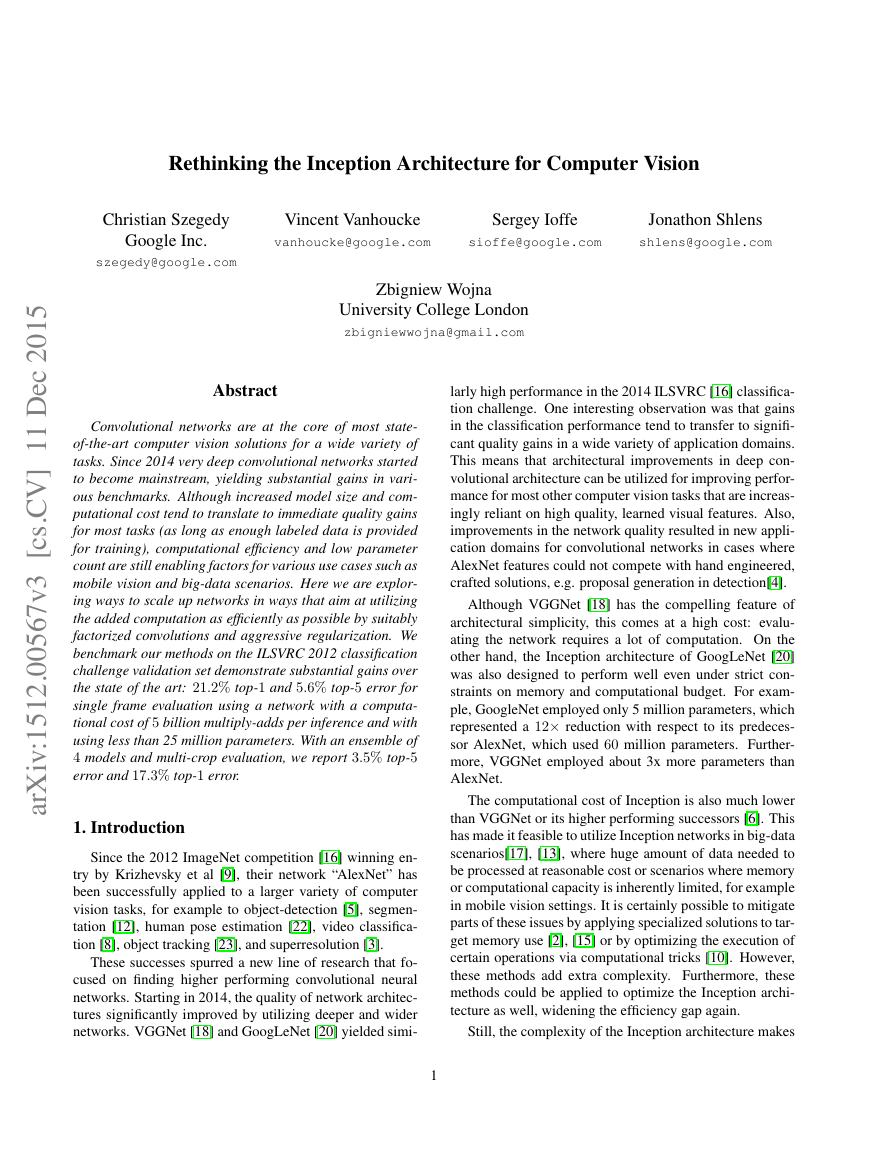
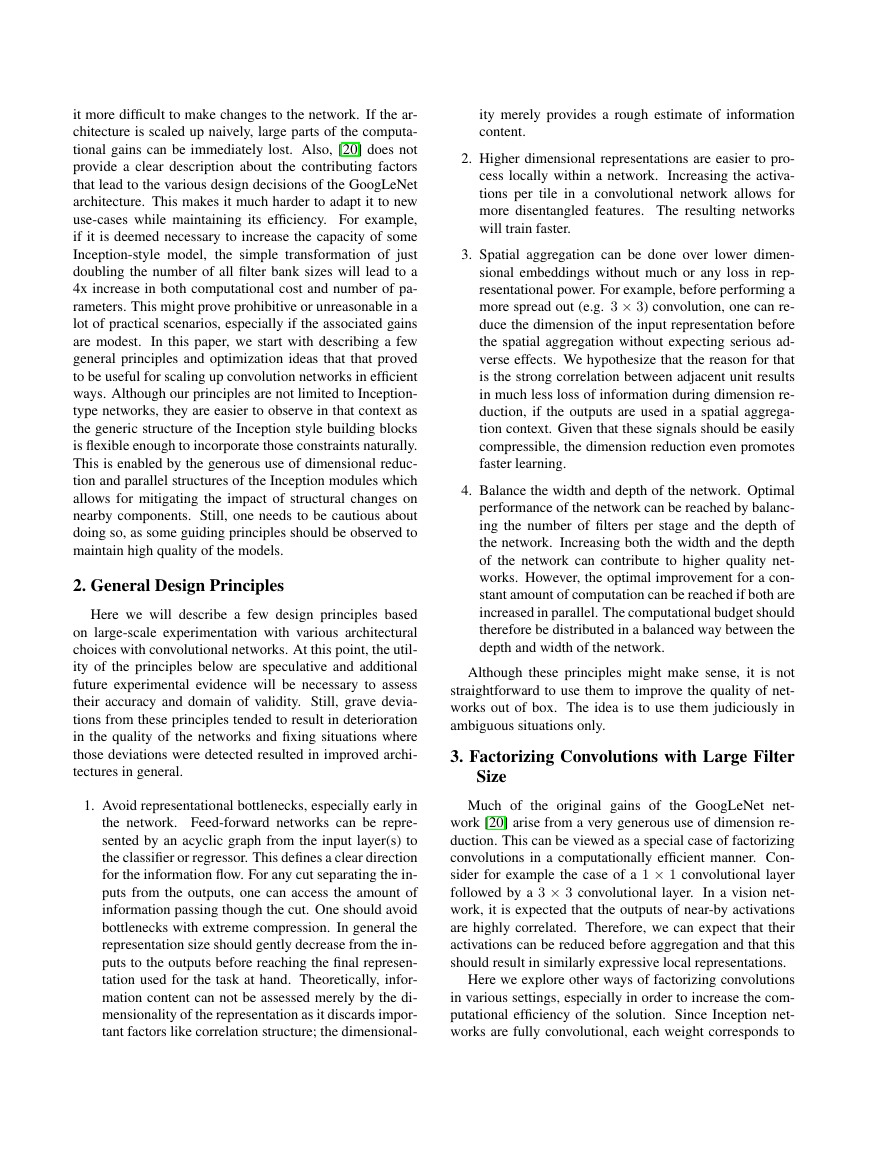
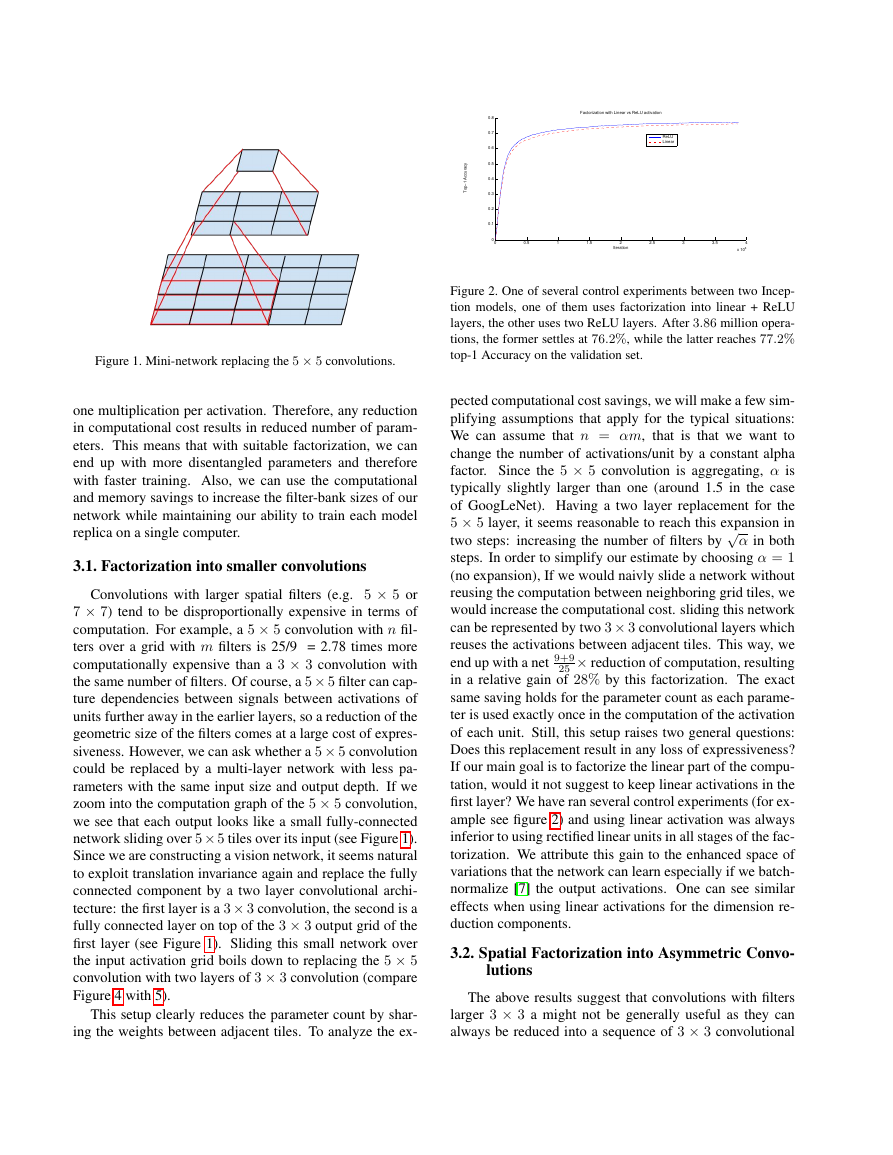
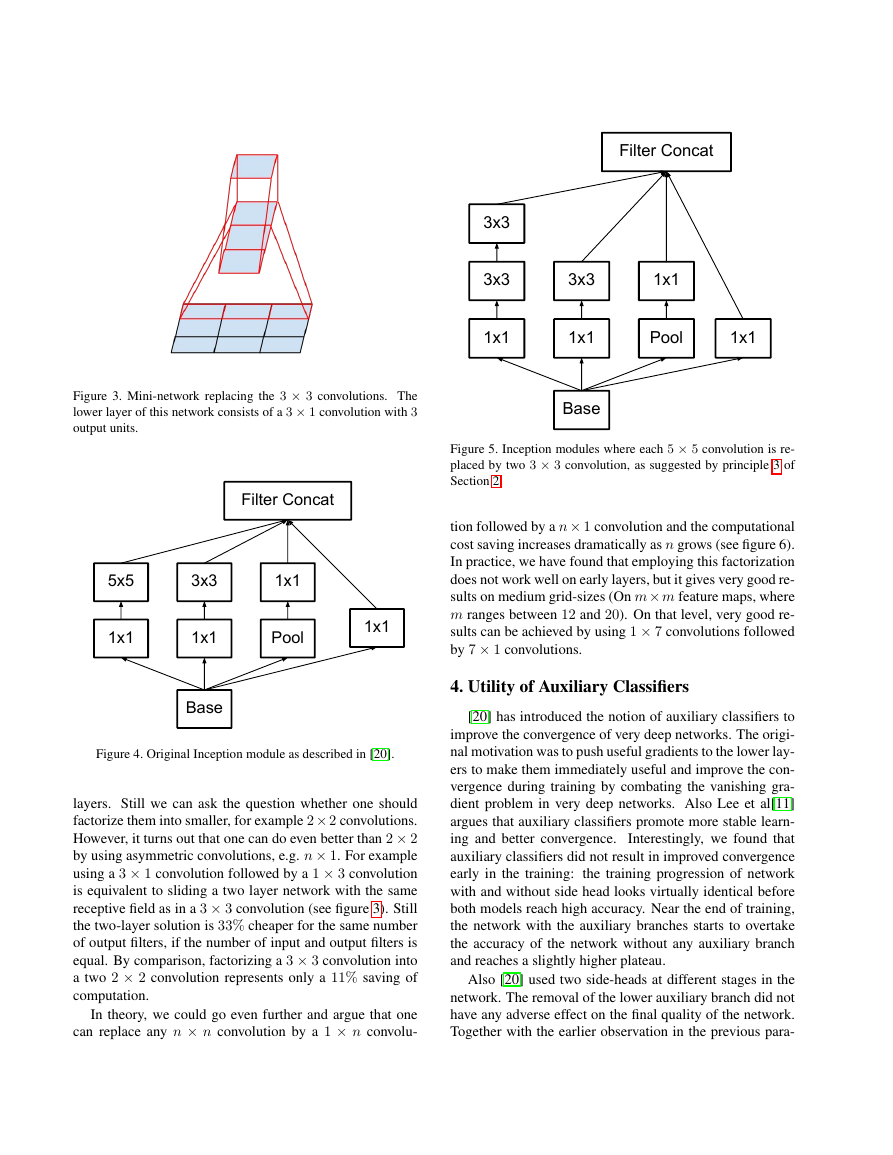

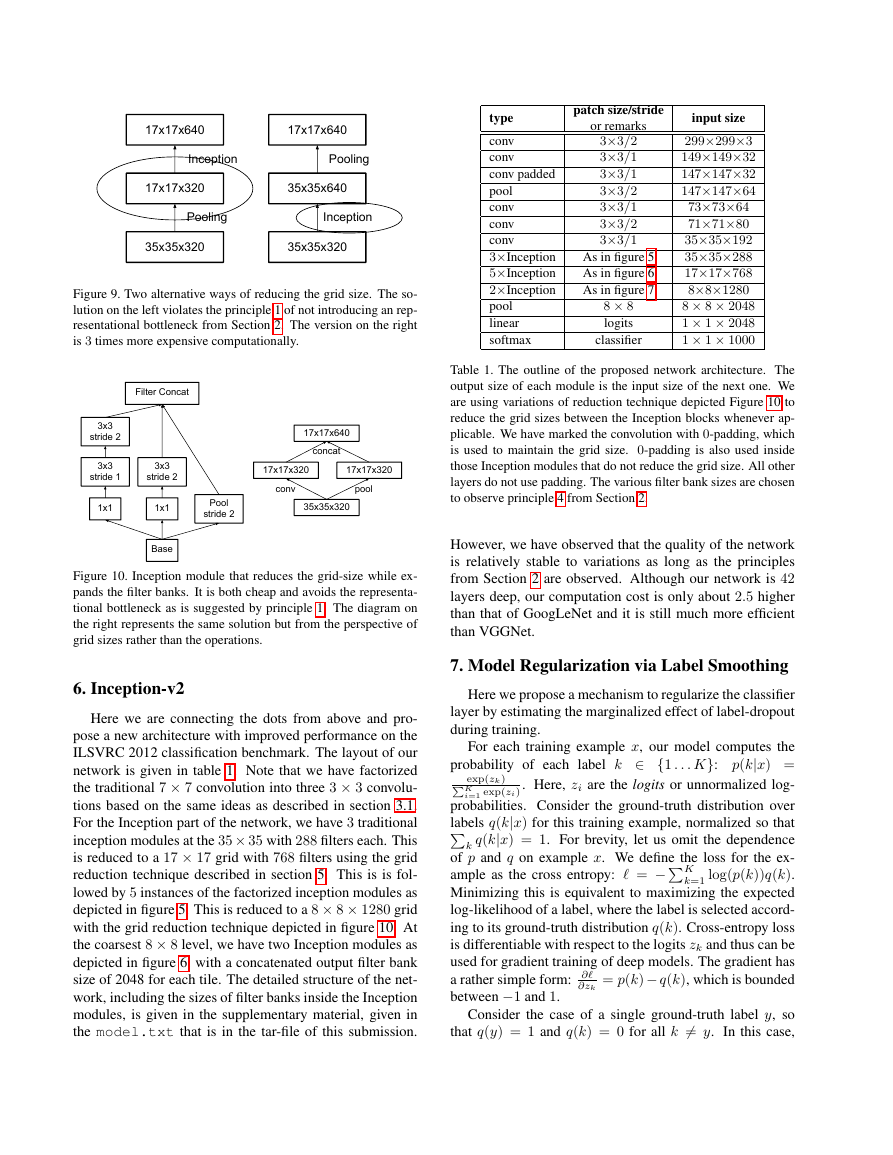
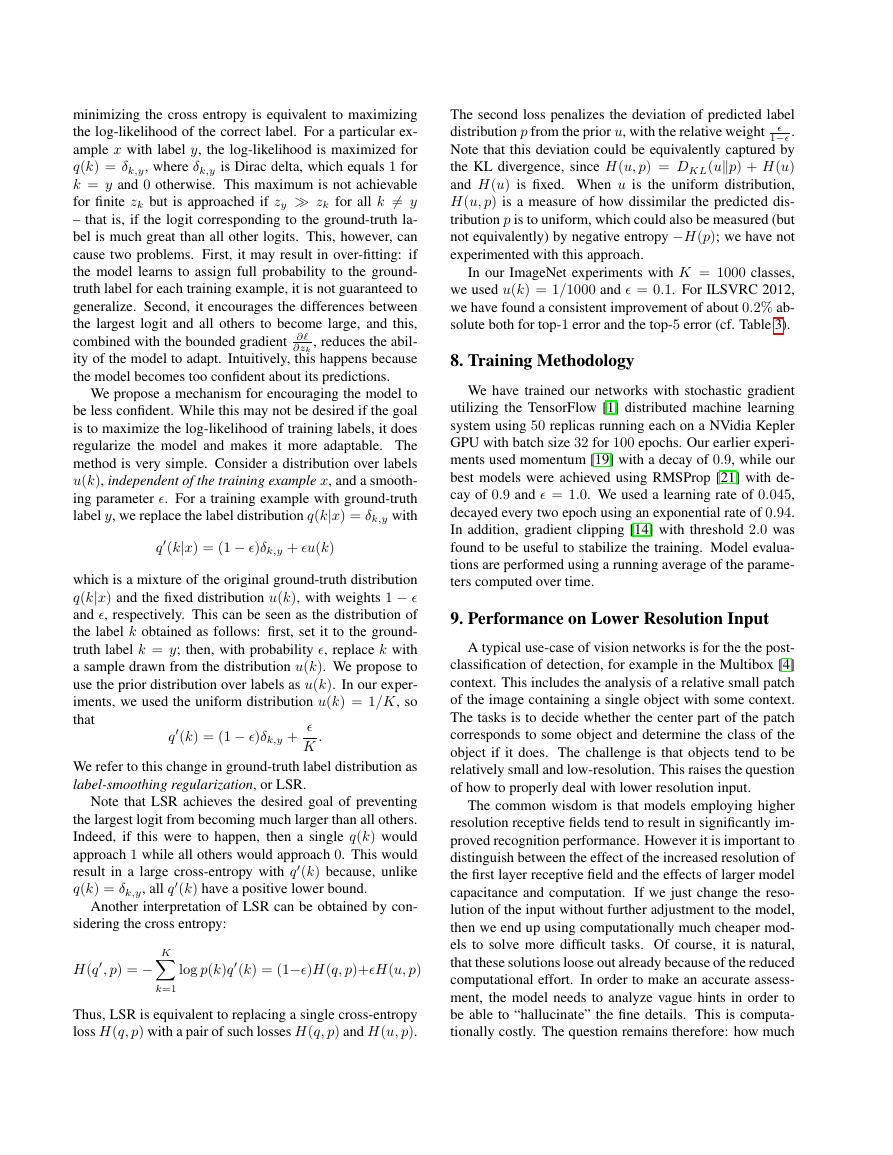
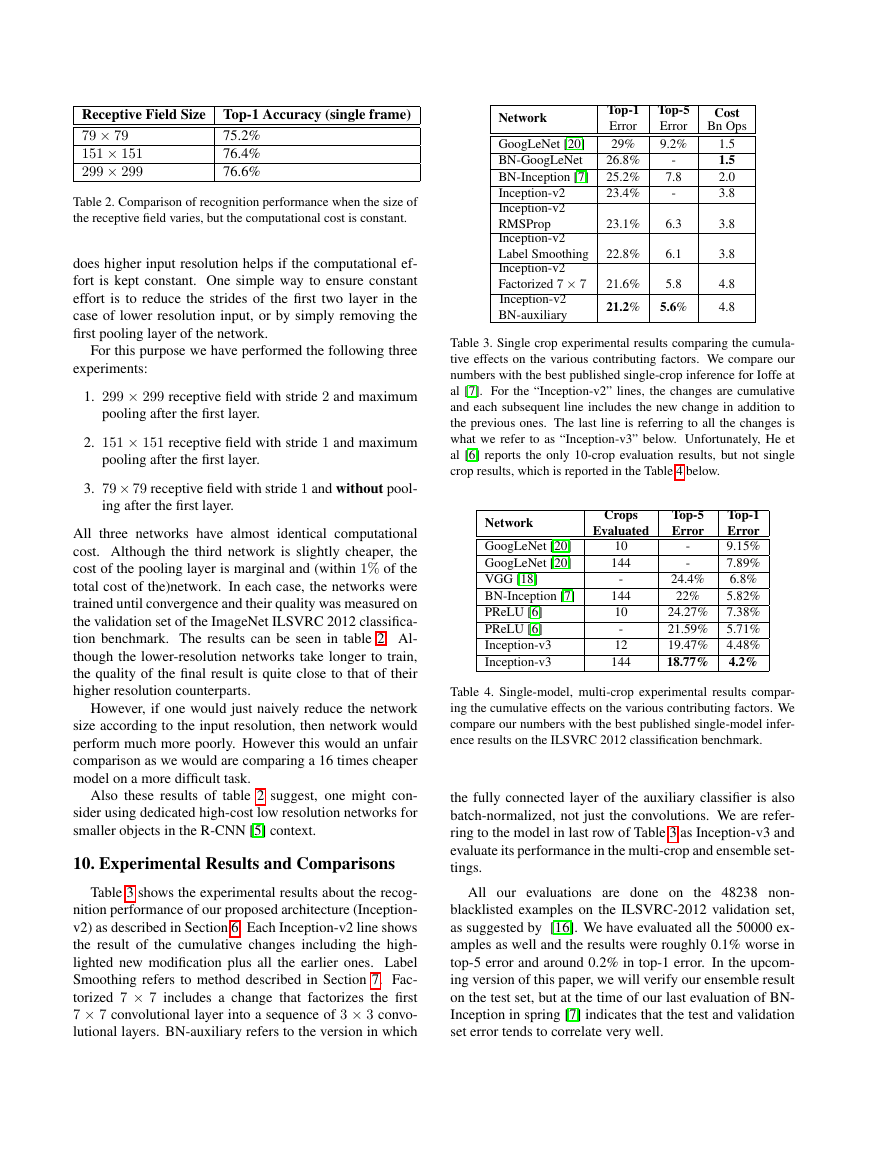








 2023年江西萍乡中考道德与法治真题及答案.doc
2023年江西萍乡中考道德与法治真题及答案.doc 2012年重庆南川中考生物真题及答案.doc
2012年重庆南川中考生物真题及答案.doc 2013年江西师范大学地理学综合及文艺理论基础考研真题.doc
2013年江西师范大学地理学综合及文艺理论基础考研真题.doc 2020年四川甘孜小升初语文真题及答案I卷.doc
2020年四川甘孜小升初语文真题及答案I卷.doc 2020年注册岩土工程师专业基础考试真题及答案.doc
2020年注册岩土工程师专业基础考试真题及答案.doc 2023-2024学年福建省厦门市九年级上学期数学月考试题及答案.doc
2023-2024学年福建省厦门市九年级上学期数学月考试题及答案.doc 2021-2022学年辽宁省沈阳市大东区九年级上学期语文期末试题及答案.doc
2021-2022学年辽宁省沈阳市大东区九年级上学期语文期末试题及答案.doc 2022-2023学年北京东城区初三第一学期物理期末试卷及答案.doc
2022-2023学年北京东城区初三第一学期物理期末试卷及答案.doc 2018上半年江西教师资格初中地理学科知识与教学能力真题及答案.doc
2018上半年江西教师资格初中地理学科知识与教学能力真题及答案.doc 2012年河北国家公务员申论考试真题及答案-省级.doc
2012年河北国家公务员申论考试真题及答案-省级.doc 2020-2021学年江苏省扬州市江都区邵樊片九年级上学期数学第一次质量检测试题及答案.doc
2020-2021学年江苏省扬州市江都区邵樊片九年级上学期数学第一次质量检测试题及答案.doc 2022下半年黑龙江教师资格证中学综合素质真题及答案.doc
2022下半年黑龙江教师资格证中学综合素质真题及答案.doc